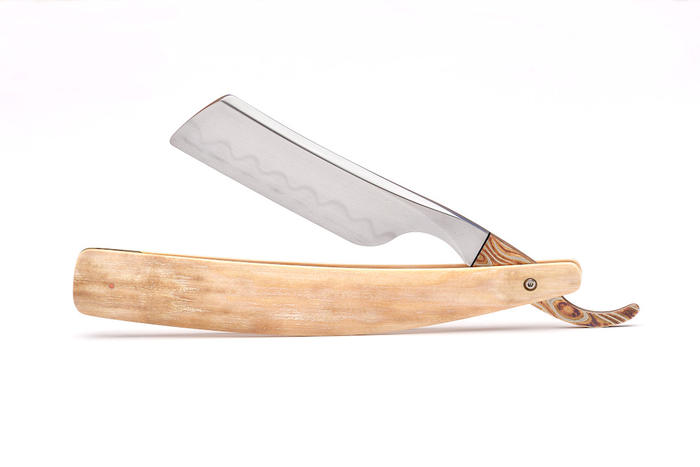Results 11 to 18 of 18
-
01-09-2012, 02:09 AM #11Indisposed

- Join Date
- Oct 2008
- Posts
- 6,038
Thanked: 1195
Simply stunning! Definitely out of my price range, but beautiful none the less. Enjoy in good health.
-
01-09-2012, 05:41 AM #12
-
01-10-2012, 03:07 AM #13
-
01-15-2012, 02:16 PM #14Electric Razor Aficionado

- Join Date
- Apr 2006
- Posts
- 3,396
Thanked: 346
I've had an Iwasaki western-style tamahagane razor for several years, so it was interesting reading your impressions of Tim's tamahagane-like razor.
Mine shaves exceptionally well, but it doesn't need any more frequent stropping than any other razor. It does rust if you so much as look at it sideways though; so I keep it dripping with oil. Not sure why Tim's needs such frequent stropping. I wonder if there's some natural vanadium or molybdenum in the Japanese iron sands.
It may not have the modern alloying elements, but it is still a hypereutectic steel, so it will be full of abrasion-resistant carbides. But the steel between the carbides will wear away more readily, so a strop will sharpen it very well. My Iwasaki and my TI "wootz" razors both seem to sharpen easily with a strop the way the old Sheffields do. But lots of razors will stay sharp for months with just a strop, I had a Heljestrand that went for nearly 200 shaves with just stropping, and a number of solingen and american razors go 120-150 shaves.
-
06-02-2021, 02:18 PM #15

Believe it, or not, I just found out about this thread! It's hard to believe it has already been nine years. I should pay better attention to what is going on...
Over the years I have learned a lot about razors made from tamahagane/Timahagane. On the manufacturing side, honing angles of 17° work much better than the 15.5° I used to use. Super narrow honing bevels are an advantage for all razors. Oroshigane is extremely important for razors. It removes a huge amount of the silica left over from smelting. Iwasaki tamahagane razors are not folded in the traditional manner, and likely have alloying elements added to the steel. There is a lot going on here.
My first Timahagane razors did require stropping about half way through the shave. That was due to the acute 15.5° honing angle not holding up as well as it does on modern steels. The Iwasaki tamahagane razors I have measured are 17° - 18°. 17° is my current standard. Early Timahagane also had higher levels of silica. These inclusions also weaken the edge. These days, pre-shave stropping is 10 strokes on softened canvas followed by 50 strokes on horsehide.
There was a lot of confusion about my old honing routine. It did not produce a secondary, or micro-bevel. I have the micrographs to prove it. But that technique, poorly executed, would produce a secondary bevel. My web site is horribly out of date. I should do something about that...
These days, all my honing is done with Jnats. My favorite finisher is a Shinden Asagi from Alex Gilmore's Hoard Find. I finish with an extremely light slurry produced by a high end Nakayama Kiita.
If the current owner of this razor would like it remade to my current standards, I will be happy to do it, free of charge. This offer goes for all my Timahagane razors. Please don't hesitate to contact me if you have any questions or comments.
-
The Following 7 Users Say Thank You to Tim Zowada For This Useful Post:
BobH (06-02-2021), celticcrusader (06-02-2021), jfk742 (06-02-2021), JOB15 (06-02-2021), markbignosekelly (06-03-2021), outback (06-03-2021), rolodave (06-02-2021)
-
06-02-2021, 09:30 PM #16

Hi Tim, thanks for following up. I have a question about the hamon on this particular blade. Is that amount of activity typical for you? It looks very subtle in the pictures but very active. Is the activity in the hamon because of the very low amount of alloying? I’ve seen plenty of W2 hamons with lots of activity but I don’t think they would be as active as that one given a similar sized piece.
-
06-03-2021, 12:23 AM #17

The amount of activity in a hamon is determined by several things. These include: steel alloy, heat treatment technique, polishing technique, photographic technique, among others. In general, low alloy steels with a carbon content of about 0.70% tend to give the most beautiful hamons. In other words, 1070 will usually make more beautiful hamons than W2. Then again, "beauty is in the eye of the beholder."
Here is an example of how photography can effect things:

This Timahagane razor was photographed with normal lighting, with an attempt to keep the hamon visible.

This is the same blade. It was photographed with oblique lighting, to show as much of the steel and hamon activity as possible. I was even able to capture the utsuri in the upper portion of the blade.
I hope this helps.
Tim Z.
-
-
06-03-2021, 10:49 PM #18

Wow, the amount of craftsmanship and thought that went into that is intimidating.


 29Likes
29Likes LinkBack URL
LinkBack URL About LinkBacks
About LinkBacks






 Reply With Quote
Reply With Quote



